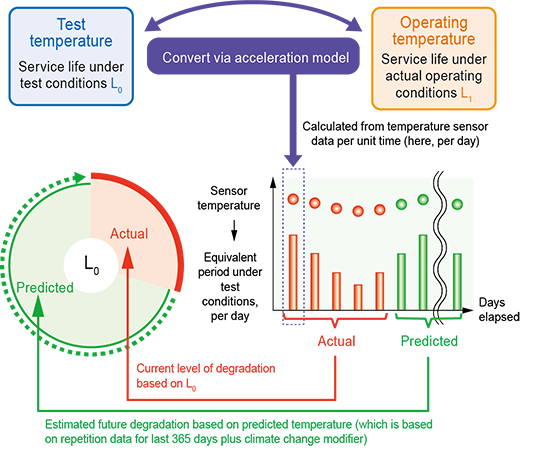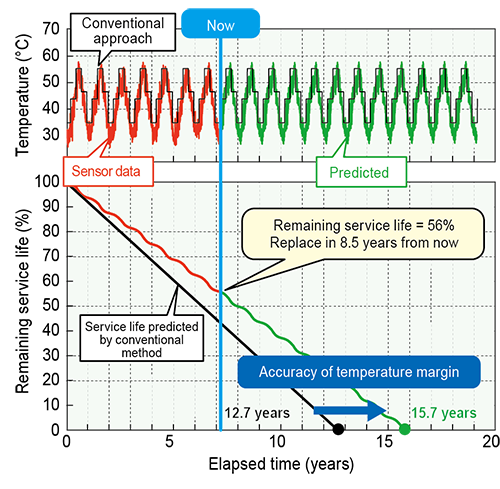20. Using temperature sensors to help predict service life of electronic signallingequipment
Given the difficulty of evaluating deterioration in signalling equipment, to date a blanket approach has been adopted whereby all equipment is replaced at defined intervals, irrespective of factors such as equipment type, operating environment and manner of use. A more tailored approach is required.
We have upgraded the existing approach for predicting service life, which uses acceleration models for electronic components and solder in signalling equipment, by adding environmental sensors to provide better information about equipment degradation and enable more accurate prediction of future degradation. Temperature is considered a key factor governing the service life of electronic signalling equipment. Our acceleration models link actual equipment operating temperatures (from sensor data) with the temperatures quoted by device and component manufacturers in reliability tests to generate more accurate predictions of degradation and service life for the equivalent period under test conditions per day (see Figure 1). The existing approach defines a specific temperature as the basis for predicting service life, then adds an error margin to reflect potential temperature variation associated with factors such as exposure to direct sunlight and relocation or reconfiguration of equipment. Our system uses data from temperature sensors and is thus able to deliver predictions that reflect actual usage conditions. Trials conducted on electronic signalling equipment located next to rail lines demonstrated that the system generates more accurate predictions than the existing approach in relation to the temperature margin (see Figure 2). Equipment service life predictions can also be based on weather data from the Meteorological Agency, but this is less accurate.
Our system can be used to determine equipment replacement intervals that better reflect the actual operating environment and usage conditions.
Other Contents
- 9. Integrated analytics platform for railways
- 10. On-board obstacle detection system suitable for low-light conditions
- 11. Tool for estimating bridge deflection from on-board track irregularity measurements
- 12. Wear measuring apparatus for overhead conductor rail using light sectioning
- 13. Imaging analysis method for detecting various anomalies in overhead contact lines
- 14. Automated crew scheduling system
- 15. Fast-track embankment structure for confined settings
- 16. Numerical analysis method for predicting interaction impacts on closely adjacent tunnels
- 17. Method for evaluating girder vibration characteristics with consideration for track rigidity
- 18. Concrete repair methodology based on crack width and location
- 19. Using expansive concrete in track slabs to minimize reinforcement
- 20. Using temperature sensors to help predict service life of electronic signallingequipment
- 21. Effective and efficient steam weeding technique
- 9. Integrated analytics platform for railways
- 10. On-board obstacle detection system suitable for low-light conditions
- 11. Tool for estimating bridge deflection from on-board track irregularity measurements
- 12. Wear measuring apparatus for overhead conductor rail using light sectioning
- 13. Imaging analysis method for detecting various anomalies in overhead contact lines
- 14. Automated crew scheduling system
- 15. Fast-track embankment structure for confined settings
- 16. Numerical analysis method for predicting interaction impacts on closely adjacent tunnels
- 17. Method for evaluating girder vibration characteristics with consideration for track rigidity
- 18. Concrete repair methodology based on crack width and location
- 19. Using expansive concrete in track slabs to minimize reinforcement
- 20. Using temperature sensors to help predict service life of electronic signallingequipment
- 21. Effective and efficient steam weeding technique


